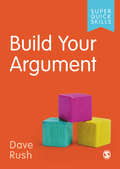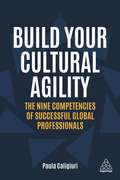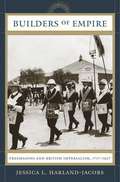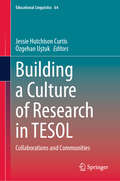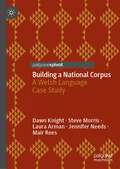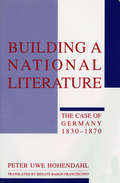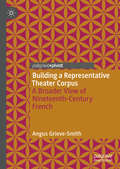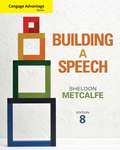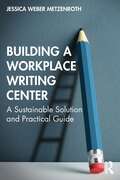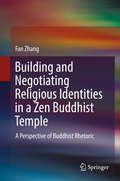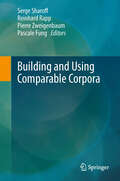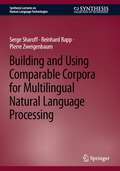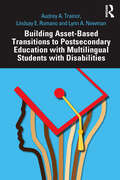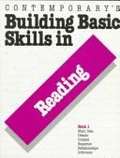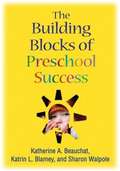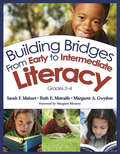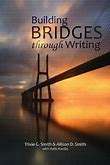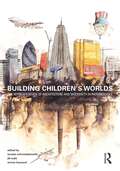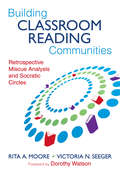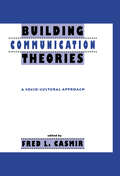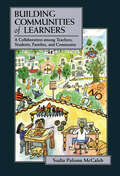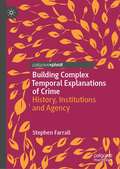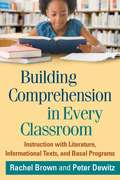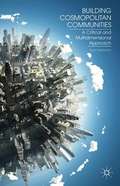- Table View
- List View
Build Your Argument (Super Quick Skills)
by Dave RushTrying to make sense of making an argument? This straightforward book breaks down how to build a convincing argument for any type of assessment. Find out what an academic argument is – and what it is not Develop a toolkit for structuring an argument effectively Learn how to use evidence and counterarguments to back up your position. Super Quick Skills provides the essential building blocks you need to succeed at university - fast. Packed with practical, positive advice on core academic and life skills, you’ll discover focused tips and strategies to use straight away. Whether it’s writing great essays, understanding referencing or managing your wellbeing, find out how to build good habits and progress your skills throughout your studies. Learn core skills quickly Apply them right away and see results Succeed in your studies and in life Super Quick Skills gives you the foundations you need to confidently navigate the ups and downs of university life.
Build Your Argument (Super Quick Skills)
by Dave RushTrying to make sense of making an argument? This straightforward book breaks down how to build a convincing argument for any type of assessment. Find out what an academic argument is – and what it is not Develop a toolkit for structuring an argument effectively Learn how to use evidence and counterarguments to back up your position. Super Quick Skills provides the essential building blocks you need to succeed at university - fast. Packed with practical, positive advice on core academic and life skills, you’ll discover focused tips and strategies to use straight away. Whether it’s writing great essays, understanding referencing or managing your wellbeing, find out how to build good habits and progress your skills throughout your studies. Learn core skills quickly Apply them right away and see results Succeed in your studies and in life Super Quick Skills gives you the foundations you need to confidently navigate the ups and downs of university life.
Build Your Cultural Agility: The Nine Competencies of Successful Global Professionals
by Paula CaligiuriThe investment in global collaboration technology now exceeds US$45 billion. Professionals who work across cultures face some of the most cognitively, psychologically and emotionally difficult challenges, regardless of whether they work virtually or in person. And they often face these challenges without the help of a corporate guide. Build Your Cultural Agility is that guide. This book offers strategies to help you develop into a successful global professional, one who can comfortably and effectively work in and with people from different cultures. This book helps you leverage your natural strengths while providing suggestions for developing cultural agility competencies. Build Your Cultural Agility focuses on nine specific competencies that comprise cultural agility: three self-management competencies (tolerance of ambiguity, curiosity and resilience), three relationship-management competencies (humility, relationship-building and perspective-taking) and three task-management competencies (cultural minimization, cultural adaptation and cultural integration). Within each chapter, the author provides a case example of that competency in action, explains why the competency is critical for success, offers a self-awareness exercise to help you determine your level of proficiency and concludes with suggestions for self-development.
Builders of Empire
by Jessica L. Harland-JacobsThey built some of the first communal structures on the empire's frontiers. The empire's most powerful proconsuls sought entrance into their lodges. Their public rituals drew dense crowds from Montreal to Madras. The Ancient Free and Accepted Masons were quintessential builders of empire, argues Jessica Harland-Jacobs. In this first study of the relationship between Freemasonry and British imperialism, Harland-Jacobs takes readers on a journey across two centuries and five continents, demonstrating that from the moment it left Britain's shores, Freemasonry proved central to the building and cohesion of the British Empire.The organization formally emerged in 1717 as a fraternity identified with the ideals of Enlightenment cosmopolitanism, such as universal brotherhood, sociability, tolerance, and benevolence. As Freemasonry spread to Europe, the Americas, Asia, Australasia, and Africa, the group's claims of cosmopolitan brotherhood were put to the test. Harland-Jacobs examines the brotherhood's role in diverse colonial settings and the impact of the empire on the brotherhood; in the process, she addresses issues of globalization, supranational identities, imperial power, fraternalism, and masculinity. By tracking an important, identifiable institution across the wide chronological and geographical expanse of the British Empire, Builders of Empire makes a significant contribution to transnational history as well as the history of the Freemasons and imperial Britain.
Building a Culture of Research in TESOL: Collaborations and Communities (Educational Linguistics #64)
by Jessie Hutchison Curtis Özgehan UştukThis volume focuses on real-world examples of teacher-researcher collaborations in TESOL in a variety of contexts. The book begins with a review of conceptual foundations and cultural factors that facilitate or hinder TESOL educators’ engagement in and with research. The chapters that follow contain diverse geographic representations, topics, and author voices engaged in research collaborations, illustrating approaches to ethical and cross-cultural challenges of such engagement, as well as successes. The proliferation of a neo-liberal agenda in education that has an impact on local TESOL classrooms has generated a sense of urgency for teacher-researcher collaborations that promote diversity, equity, and inclusion in TESOL, to which this volume responds. The chapters document how a range of TESOL educators including teachers, teacher educators, teacher candidates, and researchers developed and reflected on their collaborations with the aim of building a culture of research in English language education. This volume will be of high interest to English language and language teachers, graduate/undergraduate students, teacher educators, researchers in areas of TESOL, language education, applied linguistics, literacy education, and teacher education.
Building a National Corpus: A Welsh Language Case Study
by Dawn Knight Steve Morris Laura Arman Jennifer Needs Mair ReesThis book aims to provide a micro-level, working model of a methodological approach and practical guidelines for building a corpus, informed by the work on the CorCenCC project (Corpws Cenedlaethol Cymraeg Cyfoes - the National Corpus of Contemporary Welsh). It focuses specifically on the development of detailed design frames for corpora across communicative modes (spoken, written and e-language), and the practical processes involved in the planning, collection, transcription, collation and (re)presentation of language data. The book is designed to be of significant value and relevance to those interested in critically engaging with corpus methodology. Although Welsh is the language under discussion, the processes and approaches discussed in the building of CorCenCC can be applied to a lesser or greater extent to other language contexts. This book provides a working model, and an account of how to build a corpus dataset from which step by step guidelines for creating other linguistic corpora in any language can be easily extrapolated. It will be of value to students and scholars of minority languages and corpus linguistics.
Building a National Literature: The Case of Germany, 1830-1870
by Peter Uwe Hohendahl Renate Baron FrancisconoBuilding a National Literature boldly takes issue with traditional literary criticism for its failure to explain how literature as a body is created and shaped by institutional forces. Peter Uwe Hohendahl approaches literary history by focusing on the material and ideological structures that determine the canonical status of writers and works. He examines important elements in the making of a national literature, including the political and literary public sphere, the theory and practice of literary criticism, and the emergence of academic criticism as literary history. Hohendahl considers such key aspects of the process in Germany as the rise of liberalism and nationalism, the delineation of the borders of German literature, the idea of its history, the understanding of its cultural function, and the notion of a canon of major and minor authors.
Building a Representative Theater Corpus: A Broader View of Nineteenth-Century French
by Angus Grieve-SmithThe Digital Parisian Stage Project aims to compile a corpus of plays that are representative of performances in the theaters of Paris through history. This book surveys existing corpora that cover the nineteenth century, lays out the issue of corpus representativeness in detail, and, using a random sample of plays from this period, presents two case studies of language in use in the Napoleonic era. It presents a compelling argument for the compilation and use of representative corpora in linguistic study, and will be of interest to those working in the fields of corpus linguistics, digital humanities, and history of the theater.
Building a Speech (Cengage Advantage Books)
by Sheldon MetcalfeWith 19 chapters organized into five units, BUILDING A SPEECH, 8th EDITION guides students through the step-by-step process of developing public speaking skills through observation, peer criticism, personal experience and instructor guidance. Readings and exercises help students draft informative and persuasive speeches and improves their research and speechwriting skills. Topics such as apprehension and listening help students realize that they are not alone in their struggle to find the confidence to speak in public. BUILDING A SPEECH is grounded in the philosophy that students can master the steps of speech construction when provided with a caring environment, clear direction, and creative examples.
Building a Workplace Writing Center: A Sustainable Solution and Practical Guide
by Jessica Weber MetzenrothThis practical resource provides guidance for writing professionals to sustainably tackle the organizational writing challenges of any professional environment. Rooted in applied experience, Building a Workplace Writing Center guides readers through the process of developing a writing center, from assessing the needs of an organization and pitching the idea of a writing center, to developing a service model and measuring progress. Chapters explore what a writing center can offer, such as one-on-one writing consultations, tailored group workshops, and standardized writing guidance and resources. Although establishing a writing center requires time and a shift in culture up front, it is a rewarding process that produces measurably improved writing, less frustration with the writing and revision processes, and more confident, independent writers. This guide is an invaluable resource for professionals across industries and academia considering how to establish an embedded, sustainable, and cost-effective workplace writing center. It will be of particular interest to business and human resource managers considering how best to improve writing skills within their organizations.
Building and Negotiating Religious Identities in a Zen Buddhist Temple: A Perspective of Buddhist Rhetoric
by Fan ZhangThis book explores the practices in a Zen Buddhist temple located in Northwest Ohio against the backdrop of globalization. Drawing on the previous studies on Buddhist modernization and westernization, it provides a better understanding of the westernization of Buddhism and its adapted practices and rituals in the host culture. Using rhetorical criticism methodology, the author approaches this temple as an embodiment of Buddhist rhetoric with both discursive and non-discursive expressions within the discourses of modernity. By analyzing the rhetorical practices at the temple through abbots’ teaching videos, the temple website, members’ dharma names, and the materiality of the temple space and artifacts, the author discovers how Buddhist rhetoric functions to constitute and negotiate the religious identities of the community members through its various rituals and activities. At the same time, the author examines how the temple’s space and settings facilitate the collective the formation and preservation of the Buddhist identity. Through a nuanced discussion of Buddhist rhetoric, this book illuminates a new rhetorical methodology to understand religious identity construction. Furthermore, it offers deeper insights into the future development of modern Buddhism, which are also applicable to Buddhist practitioners and other major world religions.
Building and Using Comparable Corpora (Theory and Applications of Natural Language Processing)
by Reinhard Rapp Serge Sharoff Pierre Zweigenbaum Pascale FungThe 1990s saw a paradigm change in the use of corpus-driven methods in NLP. In the field of multilingual NLP (such as machine translation and terminology mining) this implied the use of parallel corpora. However, parallel resources are relatively scarce: many more texts are produced daily by native speakers of any given language than translated. This situation resulted in a natural drive towards the use of comparable corpora, i. e. non-parallel texts in the same domain or genre. Nevertheless, this research direction has not produced a single authoritative source suitable for researchers and students coming to the field. The proposed volume provides a reference source, identifying the state of the art in the field as well as future trends. The book is intended for specialists and students in natural language processing, machine translation and computer-assisted translation.
Building and Using Comparable Corpora for Multilingual Natural Language Processing (Synthesis Lectures on Human Language Technologies)
by Serge Sharoff Reinhard Rapp Pierre ZweigenbaumThis book provides a comprehensive overview of methods to build comparable corpora and of their applications, including machine translation, cross-lingual transfer, and various kinds of multilingual natural language processing. The authors begin with a brief history on the topic followed by a comparison to parallel resources and an explanation of why comparable corpora have become more widely used. In particular, they provide the basis for the multilingual capabilities of pre-trained models, such as BERT or GPT. The book then focuses on building comparable corpora, aligning their sentences to create a database of suitable translations, and using these sentence translations to produce dictionaries and term banks. Then, it is explained how comparable corpora can be used to build machine translation engines and to develop a wide variety of multilingual applications.
Building Asset-Based Transitions to Postsecondary Education with Multilingual Students with Disabilities
by Audrey A. Trainor Lindsay E. Romano Lynn A. NewmanThis important volume presents the results from a five-year, mixed methods study on the transition from high school to postsecondary education for young adults who, during secondary school, received both English learner and special education services. It aims to improve our understanding of, and thus the supportive service provisions for, the dually identified student population in secondary and higher education settings. The book explores dually identified students’ complex and intersectional experiences, strengths, and needs using multiple methods of inquiry, including the examination of educational transition-focused policies and practices, a comprehensive review of research results, case studies, and comparative analysis of key stakeholder perspectives for this student population. With a focus on equitable, culturally sustaining transition research and practice, the book informs graduate students, researchers, and teacher educators about how to mitigate the effects of historical marginalization, increasing our collective understanding of intersectional experiences and how they shape young adults’ choices as they leave high school and move into young adulthood.
Building Basic Skills in Reading
by Rob SaxBuilding Basic Skills in Reading, Books 1 and 2 will give you, the learner, all you need to master the basics of reading well. Together, the books give a complete program that is easy to use on your own or with a teacher in class.
Building Blocks of Preschool Success
by Katrin Blamey Katherine BeauchatWritten expressly for preschool teachers, this engaging book explains the "whats," "whys," and "how-tos" of implementing best practices for instruction in the preschool classroom. The authors show how to target key areas of language and literacy development across the entire school day, including whole-group and small-group activities, center time, transitions, and outdoor play. Detailed examples in every chapter illustrate what effective instruction and assessment look like in three distinct settings a school-based pre-kindergarten, a Head Start center with many English language learners, and a private suburban preschool. Helpful book lists, charts, and planning tools are featured, including reproducible materials.
Building Bridges From Early to Intermediate Literacy, Grades 2-4
by Sarah F. Mahurt Ruth E. Metcalfe Margaret Ann GwytherHelp all learners transition successfully from beginning to intermediate literacy levels with these classroom-tested instructional strategies and specialized assessment tools for word study, reading, and writing.
Building Children’s Worlds: The Representation of Architecture and Modernity in Picturebooks
by Torsten Schmiedeknecht Jill Rudd Emma HaywardChildren are the future architects, clients and users of our buildings. The kinds of architectural worlds they are exposed to in picturebooks during their formative years may be assumed to influence how they regard such architecture as adults. Contemporary urban environments the world over represent the various stages of modernism in architecture. This book reads that history through picturebooks and considers the kinds of national identities and histories they construct. Twelve specialist essays from international scholars address questions such as: Is modern architecture used to construct specific narratives of childhood? Is it taken to support ‘negative’ narratives of alienation on the one hand and ‘positive’ narratives of happiness on the other? Do images of modern architecture support ideas of ‘community’? Reinforce ‘family values’? If so, what kinds of architecture, community and family? How is modern architecture placed vis-à-vis the promotion of diversity (ethnic, religious, gender etc.)? How might the use of architecture in comic strips or the presence of specific kinds of building in fiction aimed at younger adults be related to the groundwork laid in picturebooks for younger readers? This book reveals what stories are told about modern architecture and shows how those stories affect future attitudes towards and expectations of the built environment.
Building Classroom Reading Communities: Retrospective Miscue Analysis and Socratic Circles
by Rita A. Moore Victoria N. SeegerDeveloped for teaching learners of all abilities, this guide presents a powerful approach to literacy development for elementary students based on individual coaching, classwide discussions, and assessment.
Building Communication Theories: A Socio/cultural Approach (Routledge Communication Series)
by Fred L. CasmirConcern with various matters related to humans as they communicate has led to an increase in both research and theorizing during the second half of the 20th century. As a matter of fact, so many scholars and so many disciplines have become involved in this process that it is virtually impossible to understand and appreciate all that has been accomplished so far. This book focuses on one important aspect of human sense-making -- theory building -- and strives to clarify the thesis that theories do not develop in some sort of social, intellectual, or cultural vacuum. They are necessarily the products of specific times, insights, and mindsets. Theories dealing with the process of communication, or communicating, are tied to socio-cultural value systems and historic factors that influence individuals in ways often inadequately understood by those who use them. The process-orientation of this book inevitably leads to an emphasis on the perceptions of human beings. Thus, the focus shifts from the subject or area called "communication" to the act of communicating. Finally, this volume offers insight into how the process of human sense-making has evolved in those academic fields commonly identified as communication, rhetoric, speech communication or speech, within specific socio-cultural settings.
Building Communities of Learners: A Collaboration Among Teachers, Students, Families, and Community
by Sudia Paloma McCalebThis popular text shows how teachers can create partnerships with parents and students that facilitate participation in the schools while also validating home culture and family concerns and aspirations. It reflects current research and theory in several areas related to literacy development, including family literacy, bilingual and multicultural education, critical pedagogy, participatory research, cooperative learning, and feminist perspectives. Teachers of students who are immigrants, non-native speakers of English, and members of marginalized groups will find this book especially pertinent.
Building Complex Temporal Explanations of Crime: History, Institutions and Agency (Critical Criminological Perspectives)
by Stephen FarrallThis book seeks to bring understanding of both complexity and temporality into criminology. It outlines why these are important in criminological models of causation and explanation and explores them by drawing on theories and approaches in political science, comparative history, social theory and systems analyses. It discusses what is meant by complexity and introduces historical institutionalism (which is rarely used in criminology) to criminological audiences; it introduces what is known as ‘why-because’ analyses to the social sciences. This style of thinking is used to explore the causes of major transportation accidents (such as aeroplane or ferry disasters) and involves the integration of structural, organisational and agentic inputs in accounting for such disasters. Chapters on realistic evaluation, theories of structuration and agency, and research design and research methods are included with an example project based on the author's recent studies of Thatcherism which shows how these theories can be applied to empirical data. This book speaks to those interested in criminology, sociology, political science, research methods and the wider social sciences.
Building Comprehension in Every Classroom
by Peter Dewitz Rachel Brown Nell K. DukeThis book presents a practical model and specific unit- and lesson-planning ideas for enhancing students' reading comprehension in any 2-8 classroom. The authors provide innovative suggestions that help teachers construct a comprehension curriculum organized around literature, informational texts, or a basal reading program. Vivid case examples and vignettes bring to life ways to build the knowledge, strategies, and motivation that children need to engage with different types of texts and become proficient, enthusiastic readers. Graphic elements throughout the volume link instructional and assessment practices directly to the Common Core standards.
Building Cosmopolitan Communities
by Amos NascimentoBuilding Cosmopolitan Communities contributes to current cosmopolitanism debates by evaluating the justification and application of norms and human rights in different communitarian settings in order to achieve cosmopolitan ideals. Relying on a critical tradition that spans from Kant to contemporary discourse philosophy, Nascimento proposes the concept of a "multidimensional discourse community. " The multidimensional model is applied and tested in various dialogues, resulting in a new cosmopolitan ideal based on a contemporary discursive paradigm. As the first scholarly text to provide an interdisciplinary survey of the theories and discourses on human rights and cosmopolitanism, Building Cosmopolitan Communities is a valuable resource to scholars of philosophy, political science, social theory, and globalization studies.
